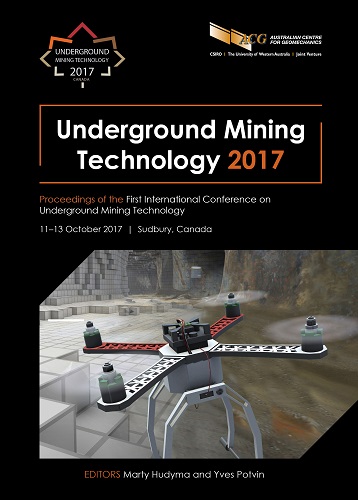Underground mineral processing – Gekko Systems modular Python

|
Authors: Baines, J; Bell, T; Grigg, N |
DOI https://doi.org/10.36487/ACG_rep/1710_51_Bell
Cite As:
Baines, J, Bell, T & Grigg, N 2017, 'Underground mineral processing – Gekko Systems modular Python', in M Hudyma & Y Potvin (eds), UMT 2017: Proceedings of the First International Conference on Underground Mining Technology, Australian Centre for Geomechanics, Perth, pp. 625-635, https://doi.org/10.36487/ACG_rep/1710_51_Bell
Abstract:
Underground mining technology advancements and automation have progressed significantly in the past 50 years; often the refinement of existing equipment, and the automation thereof, which in effect does the same thing. It’s often about progressing mining methods that have incremental impacts, rather than stepchange benefits. Processing, both currently and traditionally, has been a function that takes place on the surface in the vast majority of cases, with preludes into processing underground remaining at crushing only. This paper examines the benefits of underground processing as a viable, game changing and sustainable option in the right application of amenability with the orebody and operating environment. It will provide an overview on pre-concentration utilising gravity separation and flotation; both proven physical processes that minimise the need for toxic chemical processes. As well as the inherent benefits of minimising surface disturbance with underground processing, the possibilities of using underground plant residue placement as backfill removes one of the biggest operating cost impacts; residue/tailings placement and storage facility construction. There will be a summary of the commercial benefits around haulage reduction, and operational benefits analysis looking at the impacts of ‘mine call factor’ and what better management of this can do to the overall economics of an underground mine. Of all the measurable economic benefits of underground pre-concentration (processing), the single biggest benefit is measured in lowest life-of-mine costs through reduction of cut-off grade; this provides increased reserves with no additional input of capital. Analysis of a summation of benefits concluded that the overall operating cost of a suitable mining operation could possibly be reduced by up to 50%, and this paper will highlight why, and how, this can be a reality. In conjunction to the environmental and commercial benefits, there will be a presentation of the engineering aspects associated with such an underground plant, its design requirements, strength testing processes, dimensions and suitability to common drive/tunnel sizes. This paper will address the practical aspects of what it takes to make this concept a commercial and operational reality; addressing areas associated with module turning circles, transport, towability (mobility) and levelling using hydraulic jacks. There will be presentation of bogey wheel design and critical design elements for operator safety. Automation is a key component; there will be information that highlights why this approach has the potential to round out modern thinking with respect to remote mining equipment. The goal for underground processing is to run the plant completely remotely with minimal maintenance requirements, reducing exposure to the underground environment and, in the process, making mining safer whilst utilising stateofthe art automation practice. Challenges associated with underground processing, both technical and human, will be summarised. It will demonstrate that with a shift in thinking and collaborative courage between all the required disciplines, stepchange benefits can be made for the betterment of a more efficient and sustainable industry.
Keywords: underground processing, Python, mine equipment and automation, mine economics
References:
Bamber, AS, Klein, B, Morin, M & Scoble, MJ 2004, ‘Reducing selectivity in narrow-vein mining through the integration of underground pre-concentration’, InfoMine Inc., viewed 19 April 2017, www.infomine.com/publications/docs/
Bamber2004.pdf
Bamber, AS, Klein, B, Morin, M & Scoble, MJ 2005, ‘Integration of pre-concentration underground: Reducing mining costs’, Proceedings of the XVII International Conference on Mine Planning and Equipment Selection, Banff, Alberta.
Bamber, AS, Klein, B, Scoble, MJ & Widdifield, J 2006, ‘Integrated underground mining and processing of massive sulphide ores,’ Proceedings of the 38th Annual Meeting of the Canadian Mineral Processors, Canadian Institute of Mining, Metallurgy and Petroleum, Westmount.
Devereux, RB & Gray, AH 1996, The Continuous Mining, Transport and Treatment System, Patent Application PCT/AU1996/000174, World Intellectual Property Organization, viewed 12 June 2017,
Grigg, NJ & GJ Delemontex 2015, ‘The pre‐concentration of precious and base metal deposits using the Inline Pressure Jig (IPJ); higher feed grades and more metal,’ Proceedings of the XXVIII International Mineral Processing Conference, Canadian Institute of Mining, Metallurgy and Petroleum, Westmount.
Lane, G, Fountain, C & La Brooy, S 2008, ‘Developments in processing to match future mining opportunities’, Proceedings of the First International Future Mining Conference, The Australasian Institute of Mining and Metallurgy, Melbourne, pp. 221–227.
© Copyright 2025, Australian Centre for Geomechanics (ACG), The University of Western Australia. All rights reserved.
View copyright/legal information
Please direct any queries or error reports to repository-acg@uwa.edu.au
View copyright/legal information
Please direct any queries or error reports to repository-acg@uwa.edu.au